There are 56 nationalities in China; each has its unique costume culture. This article is a guide to the most distinguished trait for each ethnic clothing in China.
1. Mongolian Clothing
Mongolia is a group that enjoys a long history in China. The traditional Mongolian costumes often have four parts: accessories, garments, belts, and boots. Mongolian women usually wear a lot of jewelry made of agate, pearls, gold, and silver.
2. Hui Ethnic Clothing
The primary characteristic of the Hui clothing lies in the head ornaments. Men wear white hats, and women wear a turban.
3.Miao Ethnic Clothing
Miao art and crafts like cross-stitch work, embroidery, brocade, batik, and jewelry making are well known globally. It's no wonder that Miao clothes are famous for the glorious color, complicated silver accessories, and intriguing cultural connotations.
4. Dai Ethnic Clothing
Dai people mainly live in Yunnan's tropical areas; therefore, their costumes are simple, light, and colorful. The most common clothes are straight skirt.
5. Lisu Ethnic Clothing
Lisu people mostly resided in the Nujiang River area, Yunnan. Their costumes are very characteristic. Women often wear embroidered tops, linen skirts, and ornaments like red and white beads, corals, and shells, while men wear short tops inside, linen gowns outside, knife on the left side of the waist, and arrow bags on the right.
6. Tibetan Clothing
As one of the oldest nationalities in China, Tibet has a rich culture in clothes. The Tibetan clothing's necessary parts are baggy gowns, long sleeves, big open front, right lapel, long skirt, tall boots, braided hair, and loads of gold and silver beads and jade jewelry.
7. Zhuang Ethnic Clothing
As the most populous ethnic group in China, Zhuang people excel at weaving and embroidering. The Zhuang fabric and brocades are famous for their exquisite patterns and splendid color. Meanwhile, the stylish Zhuang batik is also well-known in China.
8. Chaoxian Ethnic Clothing
Chaoxian people mainly live in northeast China, and they love plain-colored clothes, especially white color. Therefore, Chaoxian people also claim themselves as the "White People."
9. Gaoshan Ethnic Clothing
Gaoshan people often wear red, yellow, or black colored clothes. Men can wear a waist skirt, overskirt, and gowns, while women often have short tops, long skirts, and pants. They also like to wear flower garlands.
10. Naxi Ethnic Clothing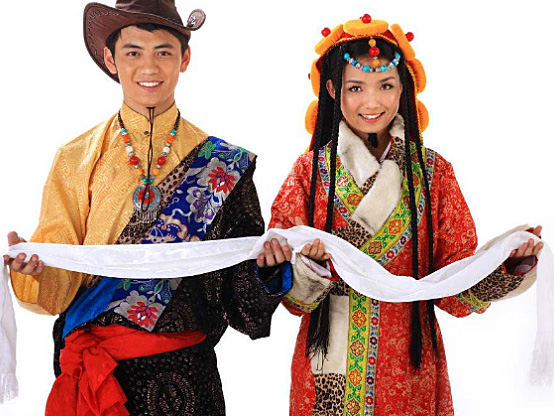
Naxi women are well-known for their industry and capability. Two distinctive features of Naxi ethnic clothing are 1. there is a seven-star shawl made of sheepskin behind the clothes; 2. the shawl is fashioned with embroidered clothing rings and hanging tassels.
11. Blang Ethnic Clothing
Blang people wear simple clothes like the Dai people. Women have collarless tight tops and tube skirts in red, green, or black, while men wear collarless cardigan tops and saggy black pants.
12. Achang Ethnic Clothing
Based on what an Achang person wears, you can judge if he/she is married. Single men often have their head wrapped in white or black cloth, while the married men can only wear navy blue headbands. Single women can braid their hair and wear white or blue cardigan tops decorated with silver buttons and blue or black pants. The married women need to comb their hair into a bun, wrap their heads with black cloth, and wear the long tube skirt.
13.Nu Ethnic Clothing
Men of Nu nationality often wear cross-neck gowns and knee-length trousers. Women usually wear cardigan tops and long shirts with black or red waistcoats.
14. Ewenki Ethnic Clothing
The primary materials for Ewenki costumes are animal skins, and the most favored colors are blue and black.
15. Oroqen Ethnic Clothing
As most Oroqen people used to engage in safari, the traditional Oroqen ethnic clothes were mostly made of deer or roe deer skins. Even the embroidery patterns on the flaps, collars, and cuffs are modeled after natural landscapes or animals.
16.Hezhen Ethnic Clothing
Fish skin clothes are the most distinctive feature of Hezhen costumes. Both Hezhen men and women wear them. Besides, they also have gowns made of roe deerskin, boots made from deerskin, and accessories made of seashells.
17.Monba Ethnic Clothing
Monba people mainly live in Menyu and Motuo areas in Tibet. In the Menyu area, people all wear Tibetan style robes, belts, brown round caps with a rimming of yellow edges, and an eye-catching gap in the front. Their boots are often red or black and made of soft leather.
18.Bai Ethnic Clothing
Bai people favor the color white, and they believe it's the representation of innocence. Besides the clothes, the most prominent part of the Bai clothing is the women's headdress, which is composed of four parts and each symbolizes four beautiful scenes in Dali, wind, flowers, snow, and moon, respectively.
19.Bonan Ethnic Clothing
The costumes of the Bonan people are similar to that of the Hui people and Dongxiang people. Men often wear white caps, white shirts, black waistcoat, blue or white trousers. While unmarried girls have bright colored skirts and soft, gauzy green silk hijab, married women wear white hats daily and black hijab when going out.
20. Buyi Ethnic Clothing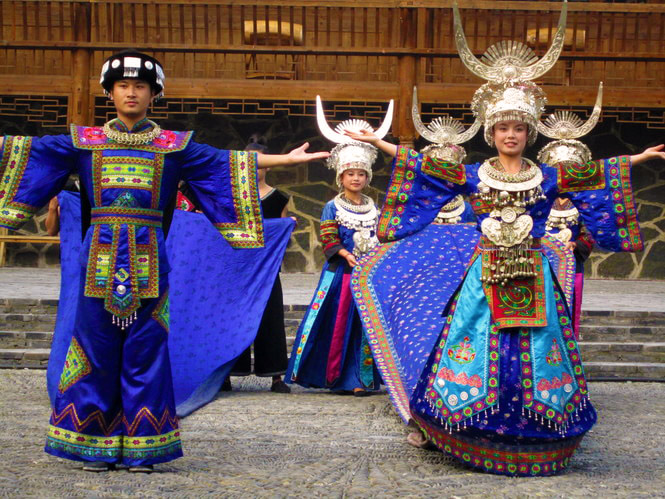
The traditions of Buyi clothes are that men wear shirts and gowns and women wear skirts. Men's clothes are relatively straightforward, while women's dresses are often decorated with all kinds of exquisite patterns.
21. Daur Ethnic Clothing
The costumes of Daur people are mostly made of animal skins. In old times, men and women wore leather hats, robes, leather pants, and leather boots. Later, Daur people began to wear cotton garments as well. The standard colors are blue, black, and gray.
22.Deang Ethnic Clothing
Deang people have a unique clothing culture. Men often wear a blue or black shirt with a large front, broad and short trousers, and black or white headscarves. Young men wear white headscarves, and old men wear black ones. On two sides of the headscarves are colorful pompons. Besides, men wear big earrings and a silver necklace. Women mostly wear short navy blue or blacktops with four or five silver buttons and long skirts with colored horizontal lines. One thing worth mentioning is that Deang women don't keep their hair. Instead, they will shave their heads and wrap them with black cloths.
23.Dongxiang Ethnic Clothing
Most Dongxiang men wear baggy robes, belts, waist knives, white or black hats; women wear embroidered tops, trousers with embroidered lace, and silk hijab.
24.Dong Ethnic Clothing
Dong men mainly wear cardigans and large headscarves. Women have big shirts with a large front and skirts or pants below. The most used colors are black, blue, white, purple, and purple-colored clothes are mainly worn on big occasions.
25.Dulong Ethnic Clothing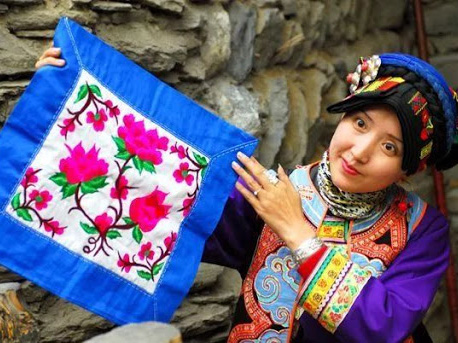
The traditional clothes of the Dulong people is a piece of linen blanket called "Yueduo." It can serve as a blanket at night and a gown in the day. Women often wear two parts, while men only wear one piece. Also, Dulong women used to wear face tattoos, colored headscarves, big earrings, chest chains, and rattan bracelets. Men often keep their hairs and wear choppers and darts.
26.Russ Ethnic Clothing
Russian men mostly wear knee-length pullover shirts and slim pants. Women have high-waisted skirts and handwoven shirts.
27.Hani Ethnic Clothing
Hani people mostly wear dark blue clothes made of Hani native nankeen. Men wear cardigan tops, long trousers, and black or white headscarves. Women have collarless tops, embroidered pants or skirts, and various silver accessories.
28.Kazak Ethnic Clothing
The costumes of Kazak people have a distinct feature. Men wear loose clothes made of animal skins, especially the sheepskin, while women like bright colored skirts and vests.
29.Jino Ethnic Clothing
The clothes of Jino people are simple and plain and mostly made of handmade cloth in blue, red, and black stripes. Men often wear saggy pants and collarless white coat, while women usually wear the embroidered white vest, collarless jacket with long sleeves, black and red skirt, and red trim, and carry a gunny bag.
30.Gin Ethnic Clothing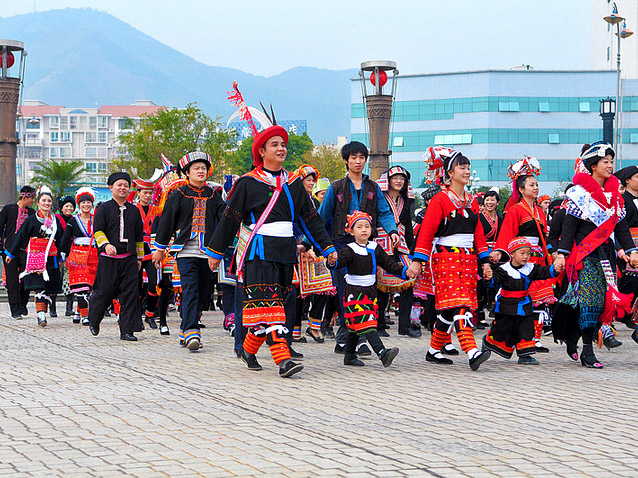
Gin men usually have a knee-length garment with an open front and narrow sleeves and fastened with a belt. Women wear a close-fitting top with slim sleeves and a piece of cloth hanging on the chest. Their pants are mostly black or brown. The other distinctive ornament about Gin people is their bamboo hats.
31.Jingpo Ethnic Clothing
Jingpo men often wear black cardigans and wide-leg trousers. Young Jingmen have white headscarf while old men have black. Jingpo women have similar tops with the men and black and red skirt below. They also like to wear silver collars and bells.
32.Kirgiz Ethnic Clothing
Kirgiz men usually wear a white round collared shirt with embroidered lacy, a coat made of sheepskin or blue and black cotton, and belts made of leather or fabric. Women often wear long dresses. Girls have a bright colored dress while married women wear dark-colored dresses. Both Kirgiz men and women love to wear waistcoats.
33.Li Ethnic Clothing
Men of the Li group usually wear collarless tops, long trousers, and wrap headscarves on their heads decorated with pheasant feathers. Women have a short shirt and black hood fashioned with embroidered patterns and beads. In big events, they also wear silver hairpins.
34.Lahu Ethnic Clothing
Lahu men wear a light-colored robe with a right lapel, long trousers, and a headscarf. Women's clothes are more like those of Tibetan women. Besides, Lahu people revere the black color.
35.Luoba Ethnic Clothing
The most prominent characteristic of Luoba Clothing is the use of wild plant fibers and animal skins. Meanwhile, Luoba women have many accessories on their costumes, indicating their wealth and social status.
36.Manchu Clothing
Manchu clothes refer to the men's robe with horse-hoof shaped cuffs, waist belts or cardigan Magua, and the qipao costumes for women, which evolved to the modern cheongsam became the formal dress for Chinese women on official occasions.
37.Maonan Ethnic Clothing
The costumes of the Maonan people are similar to that of Han people and Zhuang people. In old times, Maonan men liked to wear Tang suit, while women liked to have embroidered tops and trousers just like Han people.
38.Mulam Ethnic Clothing
The clothes of Mulam people are a lot like that of the Han people. The biggest difference is that Mulam people love the color cyan, and their costumes are often simple and plain.
39.Primi Ethnic Clothing
Pumi people absorbed the costume features of their neighboring groups and made their unique clothes. One outstanding characteristic of Primi clothing is the headband. More headbands one has, the more respected he/she is.
40.Qiang Clothing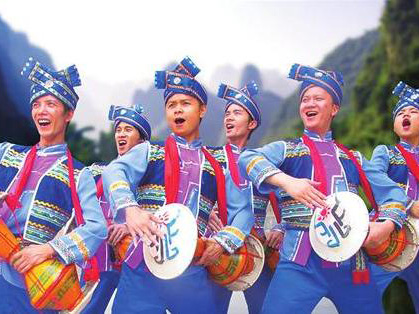
The costumes of the Qiang people are quite gorgeous. Men and women have similar clothes. They like to wear cyan or white headscarf, linen garment, a sleeveless vest made of goatskin, and puttees. The only difference is that women wear patterned tile-shaped headscarfs.
41.Salar Ethnic Clothing
The traditional costumes of the Salar people are bright-colored and a lot like that of the Hui people. Salar men wear caps and women hijab just like the Hui people.
42.She Ethnic Clothing
She national clothing characteristics are mainly reflected in women's costume, which is called Phoenix Costume. The long braid tied with a red string on the head represents the head of the phoenix. The embroidered patterns in red, pink, orange, gold, and silver colors symbolize the phoenix's colorful body. The wavy golden waistband on the back of the costume is a symbol of the phoenix tail, and the tinkling silver ornament attached to the clothes can make the sound that is believed to be the voice of the phoenix. Besides, married women often wear phoenix coronet.
43.Shui Ethnic Clothing
Red and yellow are the taboo colors in Shui people. Cool colors like blue, white, and cyan are the best-favored colors. Therefore, the costumes of the Shui people are relatively simple, plain, and practical.
44.Tagik Ethnic Clothing
The most prominent feature of Tagik costumes is the hat. Tagik people always wear a round hat with a hard shell. Women often wear a long red, pink, or yellow veil on the cap.
45.Tatar Ethnic Clothing
The costumes of the Tatar people are unique. Men like to wear white embroidered shirts, short vest and black trousers. Women often wear white, yellow, or fuchsia long skirts with many frills. Besides, Tatar people love to wear hats; men often have black or white hat, while women have colorful hats decorated with beads.
46.Tujia Ethnic people
The costumes of the Tujia people are practical. Most of them are loose, have wide cuffs, and without much silver accessory.
47.Gelao Ethnic Clothing
The skirt is the primary costume for the Gelao people. Men have short skirts and women have long skirt. As their dresses don’t have any wrinkles, they are called barrel skirts.
48.Tu Ethnic Clothing
The most featured Tu clothing is colorful sleeves for Tu women. There are often seven-colored strips on women’s dress. From the bottom to the top, the first color is black, representing the earth. The second strip is green, meaning the grass. The third strip is yellow, representing the grain stack. The fourth strip is white, symbolizing dew. The fifth color is blue, symbolizing the sky. The sixth strip is in orange color, meaning the golden sunlight, and the last strip is in red, representing the sun.
49.Wa Ethnic Clothing
Wa people adore color red and black. Most of their costumes are black, and the accessories are red. Wa men only have a black headscarf as an ornament, while women have many ornaments like big earrings, bracelets, and thin rattan rings.
50.Uygur Ethnic Clothing
Uygur costumes are very finery and beautiful. Uygur men often have black and white-colored clothes, while women have much brighter and colorful dresses. Besides, Uygur people love flowers; it's ubiquitous to see flower patterns being embroidered on their hats, clothes, veils, bags, and shoes.
51.Uzbek Ethnic Clothing
The traditional costumes of Uzbek people are a lot like that of Urgur people. The most characteristic part is their colorful hat, which is in quadrangular shape and dark green, black, white, or purplish-red color. On top of the cap are the various geometric and floral patterns.
52.Xibe Ethnic Clothing
The traditional Xibe costumes are robes, which are similar to Manchu robes. Men mostly wear Magua, dome hat, and long boots, and their clothes are mostly in green, blue, brown or black color. Women wear pants, white socks, embroidered shoes made of cloths, and ornaments like earrings, rings, and bracelets.
53.Yao Ethnic Clothing
Yao nationality is a typical mountainous people. Men often wear simple, loose clothes in black or dark blue. While women excel at embroidery, it's common to see their clothes fashioned with all kinds of exquisite patterns. They also like to braid their hairs, wrap them around their heads, and be decorated with colorful beads.
54.Yugu Ethnic Clothing
The two most distinguishing characteristics of Yugu clothing are their high collars and hats with long tassels. Yugu people like clothes with contrasting colors like red, blue, white, and black and fashion them with silver ornaments and simple patterns.
55.Yi Ethnic Clothing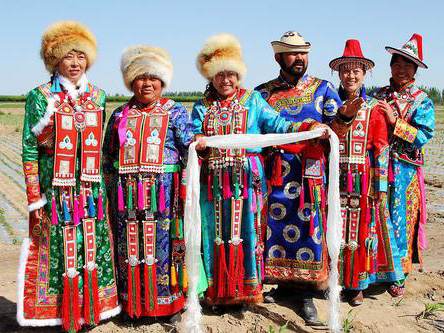
Yi people mainly inhabit Yunnan, Sichuan, Guizhou, and Guangxi. Different regions have different costumes. In general, Yi people's costumes have rich colors, diversified styles, and loads of silver accessories and embroidered patterns.
56.Han Clothing
Han nationality is the primary group in China, and the Han Clothing often refers to the traditional robes developed from imperial times. Han clothing's main characteristics lie in its plain color, loose robes, no button, and wide sleeves.
The diverse ethnic clothing culture is the epitome of rich Chinese culture. Knowing a group’s clothing is a great way to understand their culture and customs. If you are interested in China's ethnic culture, we suggest you start by appreciating their unique clothing.
You May Like
Have A Visit to 9 Populous Chinese Ethnic Groups
55 Chinese Ethnic Groups
12 Fascinating Ethnic Festivals in China











